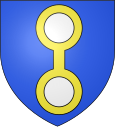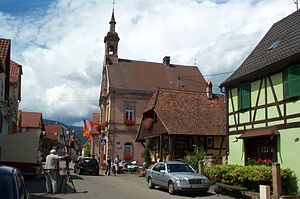Goxwiller
| Goxwiller | ||
|---|---|---|

|
|
|
| region | Grand Est | |
| Department | Bas-Rhin | |
| Arrondissement | Sélestat-Erstein | |
| Canton | Obernai | |
| Community association | Pays de Barr | |
| Coordinates | 48 ° 26 ' N , 7 ° 29' E | |
| height | 161-231 m | |
| surface | 3.30 km 2 | |
| Residents | 845 (January 1, 2017) | |
| Population density | 256 inhabitants / km 2 | |
| Post Code | 67210 | |
| INSEE code | 67164 | |
 Town hall, next to it the 17th century bakery |
||
Goxwiller (German Goxweiler , Alsatian Gogsch'willer ) is a French commune with 845 inhabitants (January 1, 2017) in the Bas-Rhin department in the Grand Est region (until 2015 Alsace ). It belongs to the Arrondissement Sélestat-Erstein and the Canton of Obernai .
geography
The municipality of Goxwiller is located about three kilometers south of Obernai and 23 kilometers southwest of Strasbourg on the edge of the Vosges . The immediate vicinity of the village is characterized by viticulture.
Neighboring communities of Goxwiller are Obernai in the north, Niedernai in the northeast, Valff in the southeast, Bourgheim in the south and Heiligenstein in the southwest.
history
Goxwiller was first mentioned in 920. Until 1522 it belonged to various abbeys, such as that of Niedermünster. Until the French Revolution , the municipality was then subordinate to the city of Strasbourg. In the 19th century, viticulture increasingly replaced agriculture and livestock.
From 1871 until the end of the First World War , Goxwiller belonged to the German Empire as part of the realm of Alsace-Lorraine and was assigned to the Erstein district in the Lower Alsace district .
Population development
| year | 1910 | 1962 | 1968 | 1975 | 1982 | 1990 | 1999 | 2006 | 2017 |
| Residents | 638 | 496 | 547 | 635 | 664 | 669 | 733 | 778 | 845 |
Culture and sights
Goxwiller was originally a street village that mainly consisted of winegrowers' and farmhouses. In the village there are six wells (two of them from the 16th century) and a bakery from the 17th century (142, rue Principale). The bakery was in operation until the end of the 19th century and was then used as a residential building. When it threatened to deteriorate at the end of the 20th century, it was finally bought by the community, restored and converted into a community house. The fire in the oven is re-lit at local festivities to bake bread and tarte flambée . The wine press from 1669 housed there can also be viewed.
In the church of St-Jean , whose choir tower partly dates back to the Gothic period , there is an organ by Johann-Conrad Sauer from 1811. The church also houses two frescoes from the 15th century, St. Antonius and St. Christophorus represent.
Transport links
Goxwiller is on the Strasbourg- Sélestat railway line . The station was demolished in the 1980s and replaced by a stop with a shelter. The national road 422 brushes the municipality on its course between Strasbourg and Sélestat. The A 35 motorway runs a few 100 meters east of the village . Goxwiller is connected to this via exit 12.
Personalities
From 1963 until her death in 2001, the painter Hélène de Beauvoir , Simone de Beauvoir's sister , lived in a former winery in Goxwiller. The French architect Jacques Albert Brion was born on June 8, 1843 in Goxwiller († 1910 in Strasbourg).
literature
- Le Patrimoine des Communes du Bas-Rhin. Flohic Editions, Volume 2, Charenton-le-Pont 1999, ISBN 2-84234-055-8 , pp. 908-910.
- Goxwiller: entre plaine et montagne, il est un lieu de libertés . Editions Coprur, Strasbourg 1989, ISBN 2-903297-20-7 .


